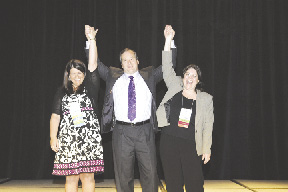Founded in 1973, Community Associations Institute (CAI) is dedicated to supporting board members and homeowners living in condominium associations as well as the professionals who work with them. It is estimated that more than 60 million Americans live in more than 300,000 association-governed communities across the country.
For more than 37 years the institute has provided education and resources to its members who include community association volunteer leaders, professional managers, professional management firms and the companies that provide products and services to the industry.
Membership has grown steadily since its founding - from 1,000 members in 1975 to 10,000 in 1988, 15,000 in 1996, 25,000 in 2005 and at the 2010 National Conference & Exposition at Caesars Palace in Las Vegas, CAI welcomed its 30,000th member.
"We're pleased to reach this milestone, especially in today's economic climate," said CAI president Michael Nagle, "Our membership grew by more than 5,000 members between 2005 and early 2010 despite a severe recession during the past few years. That speaks volumes about the value CAI membership provides to homeowner volunteer leaders and the professionals who support associations across the country."
With 58 chapters and the CAI New England chapter ranking 3rd in size among them, the institute marks many milestones over the decades. Among them:
*1973 CAI is founded;
*1975 Research Foundation created - devoted to research, development & scholarship;
*1980 First Community Association Law Seminar
*1982 Professional Community Association Manager (PCAM) designation
*1986 First state Legislative Action Committee (LAC);
*1995 National Board of Certification for Community Association Managers (NBC-CAM) founded;
*1998 Reserve Specialist (RS) designation;
*2003 Rights and Responsibilities for Better Communities;
*2003 Community Insurance and Risk Management Specialist designation;
*2007 Community Association Governance Guidelines; and
*2009 Board Member Basics education unit.
"A membership association cannot grow—in either size or effectiveness—without dedicated staff and member volunteers," said CAI chief executive officer Thomas Skiba, CAE. "CAI would not be the organization it is today without the commitment and expertise of thousands of member volunteers during the past 38 years. Add that to skilled and dedicated national and chapter staff and you have the ingredients for continued long-term success."
Local Members Recognized
The Rhode Island Legislative Action Committee (RILAC) and its volunteer members were also honored at the Vegas meeting and presented the Legislative Action Committee of the Year award. The RILAC, in only its third year of existence, has already chalked up an impressive track record of accomplishments. Following its 2008 success in getting priority lien legislation passed to allow associations to recover past-due assessments in foreclosure, in 2009, the LAC helped get legislation passed that allows associations to borrow money as a means to fund repair and improvement projects to common elements as an alternative to special assessments. Notes New England chapter executive director Claudette Carini, "Since the committee's inception, members of the RILAC have worked tirelessly to ensure that the best interests of condominium associations and their homeowners are represented in that state. The commitment of these volunteers has been inspiring and their achievements have already helped countless condominiums and owners in Rhode Island."
CAI is dedicated to successful common-interest communities, providing education, resources and public policy support to associations, board members, community managers and other professionals who work on behalf of associations. Visit www.caine.org for more information about CAI and the New England chapter.
 (1).png)








